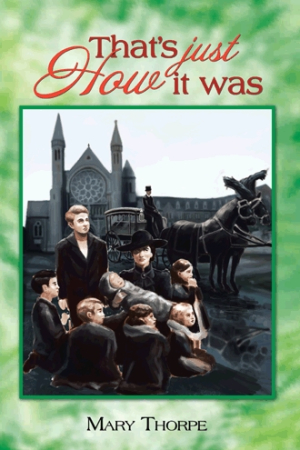That's Just How It Was
Bridget’s story is a fascinating vehicle for understanding the Irish revolution.
Mary Thorpe’s debut weaves Irish history into a loving family biography, with the author chronicling her grandmother Bridget’s rise from a destitute childhood into hardscrabble self-sufficiency and a rewarding family life. That’s Just How It Was is a moving family tale through which much can be gleaned about life during the push for Irish independence.
Thorpe begins her story before Bridget’s birth, with the potato famine. She records, in stark detail, the rampant death and need that characterized rural Ireland, thanks in no small part to the impassivity of foreign rulers. Against this backdrop come Bridget’s parents, whose own survival seems a minor miracle. Thorpe poignantly melds historical fact with family legend, highlighting the indignities of subsistence-level postfamine life, and the results are engrossing. The smells and sights of Bridget’s childhood tenement are conveyed viscerally, and the mixture of love and despair that characterizes her family home is affectingly recreated.
Bridget loses her parents to disease when she’s young, but she manages to extricate herself from their poverty. She ends up working in a grand Dublin estate. Its master encourages her toward literacy and greater civic awareness. For a girl of her station, Bridget becomes unusually well educated and self-sufficient. Thorpe brings Bridget’s experiences to vivid life, the new tastes and colors of her life becoming palpable. Bridget matures in a neighborhood shared with W. B. Yeats and Oscar Wilde. She meets a handsome railroad worker, Andrew, and marries young. Together, they build a comfortable, if still challenging, life.
Once Bridget marries, the speed of Thorpe’s narration picks up quickly. The ups and downs of the Irish revolution are maintained, though later chapters find Bridget working to better her seven children as years fly indistinguishably by. Some of the earlier magic of the biography is lost, though Thorpe still manages to connect the implications of a roiling national scene with the daily life of a rural Irishwoman.
The reader is privy to Bridget’s innumerable efforts to make her family’s life normal and happy, and the strength of her character propels the narrative toward its abrupt end. What happened after Bridget’s children leave, Thorpe alludes, is a tale for another day.
Thorpe is effective at showing how Ireland’s tribulations and successes manifested themselves in the daily lives of average Irish people. The struggles of men like Michael Collins are a useful backdrop for explaining how military service manifested itself in families outside of the city; Bridget’s own sons sign up to fight, either for or against the Irish Republic. Thorpe navigates with skill the tensions between the desire for freedom and daily concerns.
That’s Just How It Was is certain to interest all those concerned with Ireland’s tumultuous march into modernity and toward independence. Thorpe imparts her histories succinctly and with sensitivity, and Bridget’s story becomes a fascinating vehicle for understanding whole Irish movements. If its conclusion is a bit jagged, the project engages and edifies throughout. This is a satisfying, emotionally involving read.
Reviewed by
Michelle Anne Schingler
Disclosure: This article is not an endorsement, but a review. The publisher of this book provided free copies of the book and paid a small fee to have their book reviewed by a professional reviewer. Foreword Reviews and Clarion Reviews make no guarantee that the publisher will receive a positive review. Foreword Magazine, Inc. is disclosing this in accordance with the Federal Trade Commission’s 16 CFR, Part 255.

